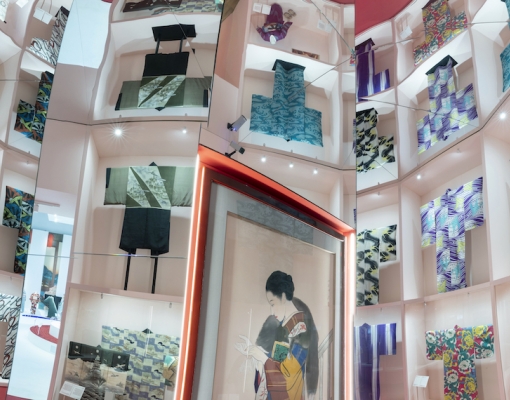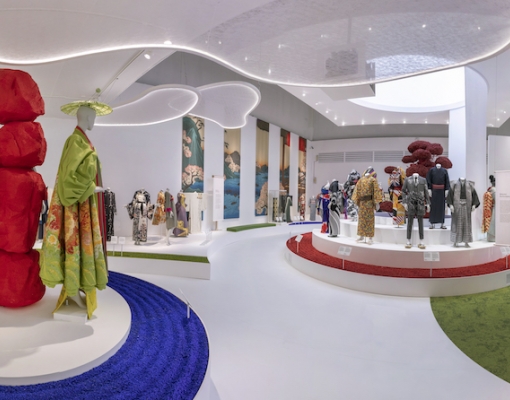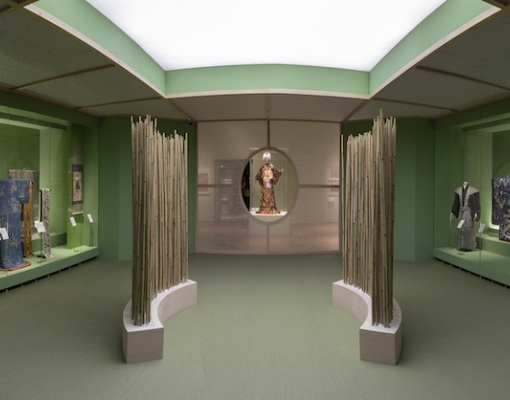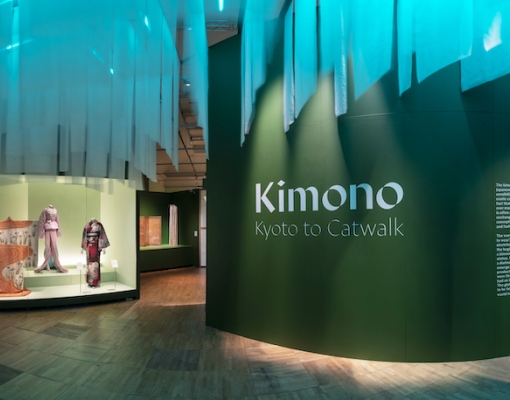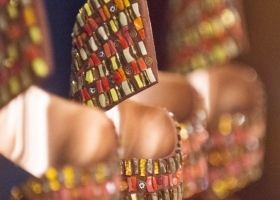
The Best ofIntima & Swim Edit
KIMONO
Kyoto to Catwalk
11 May 2021
We offer you a magnificent retrospective on the kimono, which you may have already discovered in our lates issue of the Best of Intima. A fashion icon revealed in all its glory!
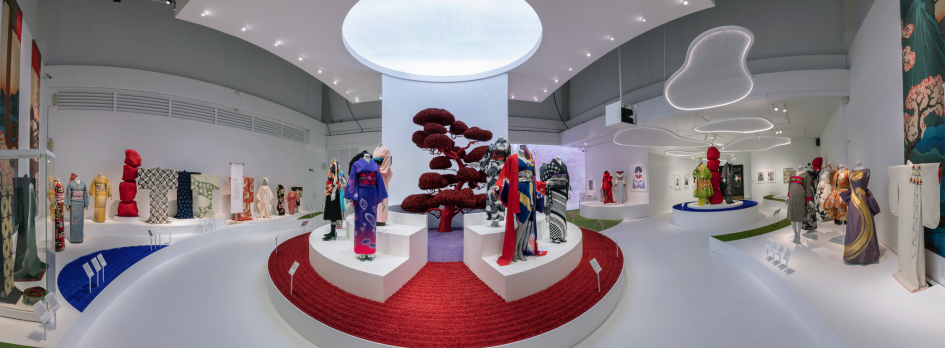
In 2020, the famous Victoria and Albert Museum in London opened the largest European exhibition "Kimono: Kyoto to Catwalk", dedicated to a clothing item as significant as the kimono. The ultimate symbol of Japan, the kimono is often perceived as traditional, timeless and unchanging. “Kimono: Kyoto to Catwalk” counters this misconception, presenting the garment as a dynamic and constantly evolving icon of fashion. The exhibition reveals the sartorial and social significance of the kimono from the 1660s to the present day, both in Japan and in the rest of the world.
Paintings, prints, video, dress accessories and other objects feature throughout the exhibition, are providing additional context to the fascinating story of the style, appeal and influence of the kimono. Over 315 works have been featured, including kimonos made especially for the exhibition, and half of them drawn from the V&A’s collections and the rest generously lent by museums and private collections in Britain, Europe, America and Japan.
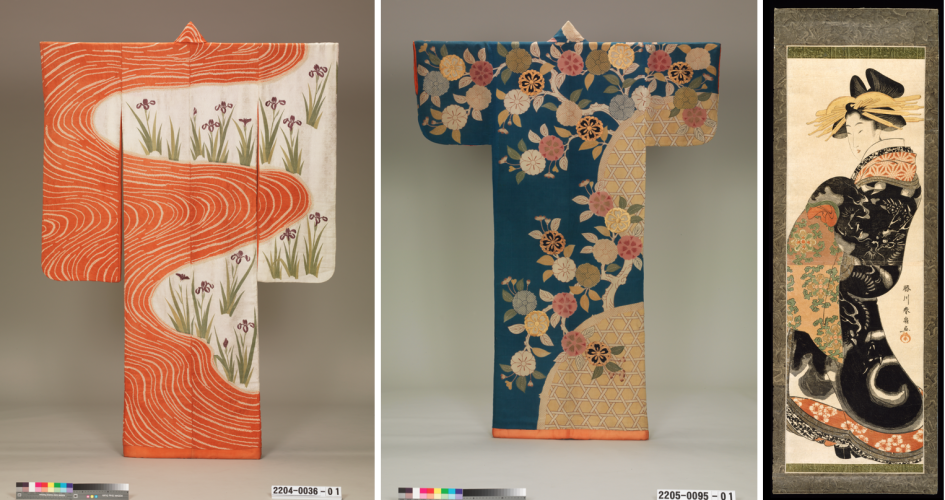
In picture above:
⁃ Outer-kimono for a young woman. Probably Kyoto, 1800-1830. Image Courtesy of the Joshibi Art Museum
⁃ Kosode with gabions and cherry trees, silk crepe, resist dye and embroidery, 1700 – 1750 Image Courtesy of the Joshibi Art Museum
⁃ Parading courtesan, woodblock print, Katsukawa Shunsen, 1804-18, Edo (Tokyo), Japan. Museum no. E.12564-1886. © Victoria and Albert Museum, London
“Kimono: Kyoto to Catwalk” begins in the mid-17th century when a vibrant fashion culture emerged in Japan. The increasingly wealthy merchant classes used the latest styles to express their affluence; confidence and taste, while leading actors and famous courtesans were the trendsetters of the day. The simple structure of the kimono focused attention on the surface, allowing for the creation of sumptuous patterns using sophisticated techniques.
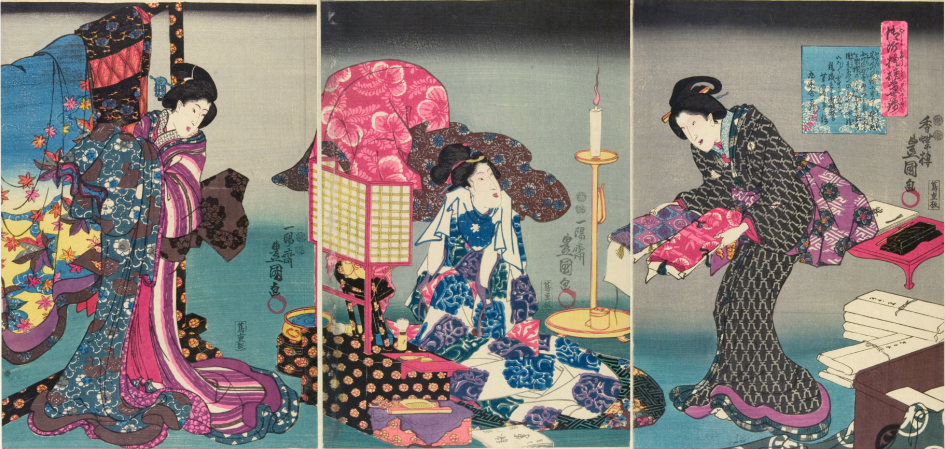
In picture above:
Fashionable brocade patterns of the Imperial Palace, woodblock print, made by Utagawa Kunisada, 1847-1852, Japan. Museum no. Circ.636 to Circ. 638– 1962. © Victoria and Albert Museum, London
Kimonos were first exported to Europe in the mid-17th century, where they had an immediate impact on existing clothing styles. Foreign fabrics were also brought to Japan and incorporated into kimono fashion. Rare survivors from this early period of cultural exchange, including garments made in Japan for the Dutch and kimonos tailored from French brocade and Indian chintz, reveal the fluid fashion relationship between East and West that resulted from the global trade network.
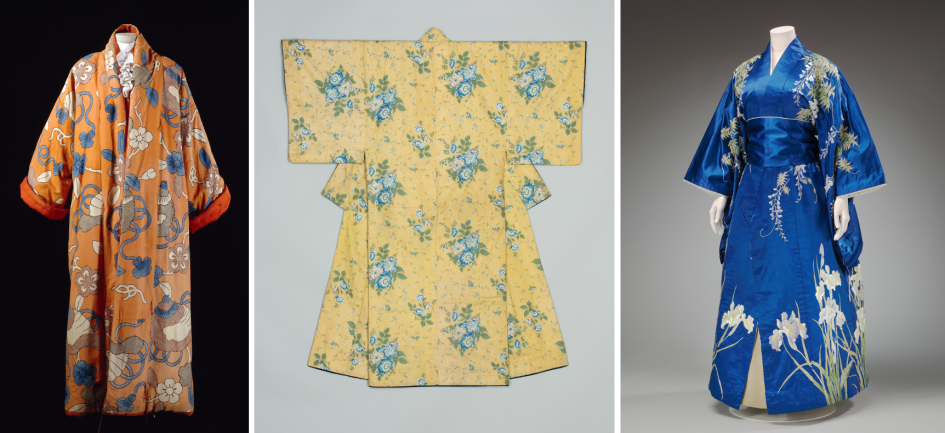
In pictures above:
⁃ Nightshirt (Japonse Rock), Japan, 1700-1750. Image Courtesy of the Collection of the Gemeentemuseum Den Haag
⁃ Under-kimono for a man (juban). Fabric made in Britain or France, tailored in Japan, 1830-1860. Image Courtesy of the Khalili Collection
⁃ Kimono for export, probably Kyoto, Japan, 1905-15 © Victoria and Albert Museum, London
The late 19th century saw a worldwide craze for Japanese art and design. Those wishing to express their artistic flair wore kimonos bought from department stores such as Liberty & Co. in London. Japan responded by making boldly embroidered ‘kimonos for foreigners’, while the domestic market was transformed by the use of European textile technology and chemical dyes.
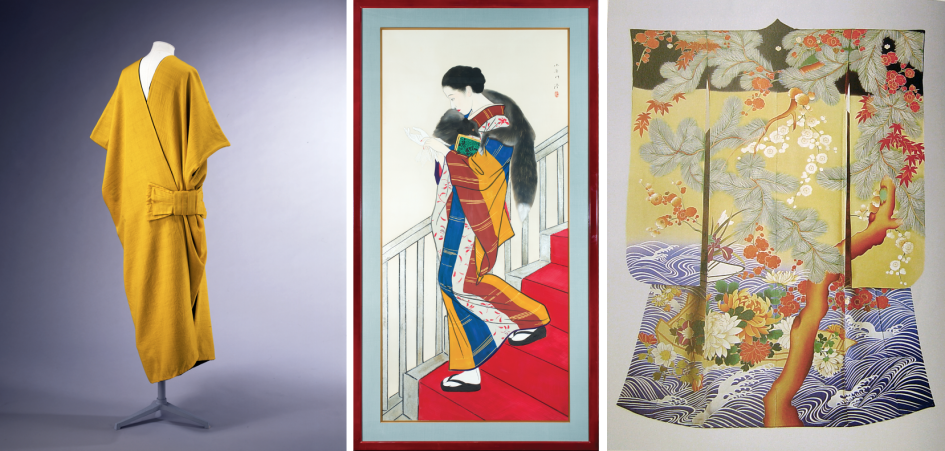
In pictures above:
⁃ Mantle, designed by Paul Poiret, about 1913, Paris. © Victoria and Albert Museum, London
⁃ Kaidan' ( staircase) by Kobayakawa Kiyoshi (1899-1948), hanging scroll, ink and colours on paper
⁃ Kimono for a young woman (furisode), 1905–20, probably Kyoto, Japan. © Khalili Collection, K106
The kimono’s biggest impact on western fashion came in the early 20th century, when designers such as Paul Poiret, Mariano Fortuny and Madeleine Vionnet abandoned tightly corseted styles in favour of loose layers of fabric that draped over the body.
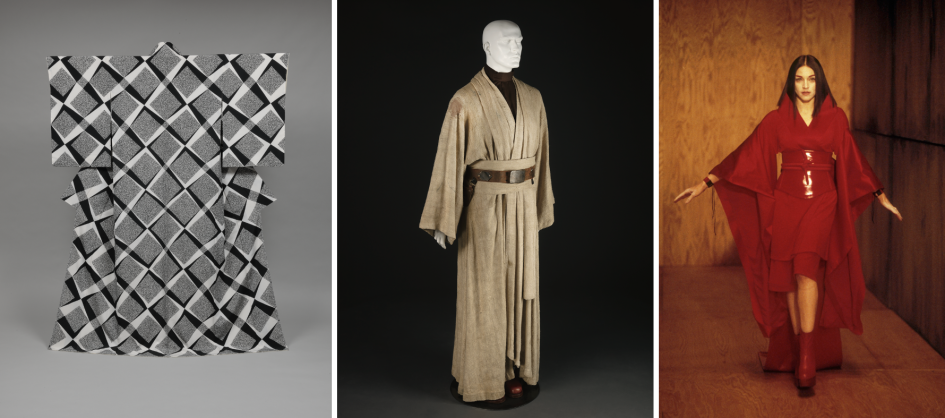
In pictures above:
⁃ 'Beyond', kimono for a woman, designed by Moriguchi Kunihiko, 2005, Kyoto, Japan. Image Courtesy of the Khalili collection. © Moriguchi Kunihiko
⁃ Costume for Obi-Wan Kenobi, played by Alec Guinness (1914-2000) in the 1977 film Star Wars: Episode IV - A New Hope, John Mollo. USA, 1977. Courtesy of Lucasfilm Ltd
⁃ Madonna, Nothing Really Matters video, 1999. Photo by Frank Micelotta © Getty Images
Kimono has continued to inspire fashion designers around the world up to today. Highlights of the exhibition include a kimono created by living national treasure Kunihiko Moriguchi, the dress designed for Björk by Alexander McQueen and worn on the cover of her album Homogenic, and original Star Wars costumes modelled on the kimono by John Mollo and Trisha Biggar. Designs by Yves Saint Laurent, Rei Kawakubo and John Galliano reveal the kimono’s role as a constant source of inspiration for fashion designers.
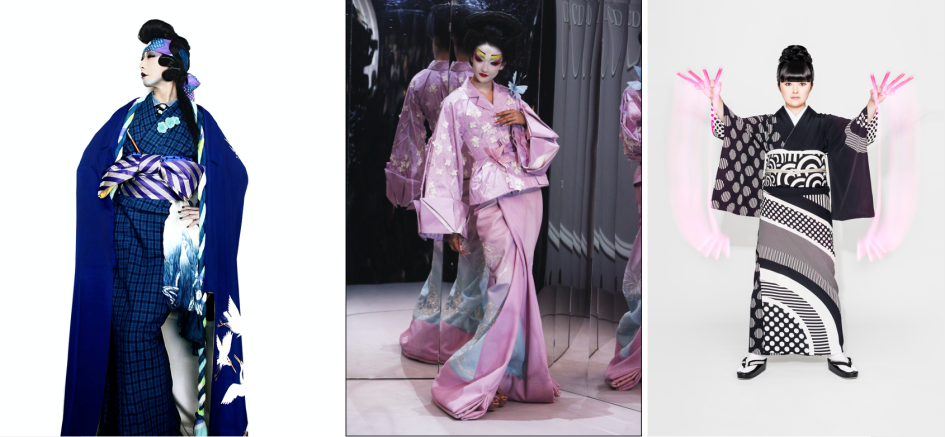
In pictures above:
⁃ Kimono Times, Akira Times, sadleiraudrey@gmail.com 2017. © Akira Times
⁃ Christian Dior, Haute Couture Spring-Summer 2007 © Getty Images
- Standing Rock Cyalume. © TAKAHASHIHIROKO INC
The kimono’s timeless, universal quality has also made it the ideal costume for film and performance. The exhibition includes the outfit worn by Toshirō Mifune in Sanjūrō, Oscar-winning costumes from Memoirs of a Geisha, and the Jean Paul Gaultier ensemble worn by Madonna in her video Nothing Really Matters.
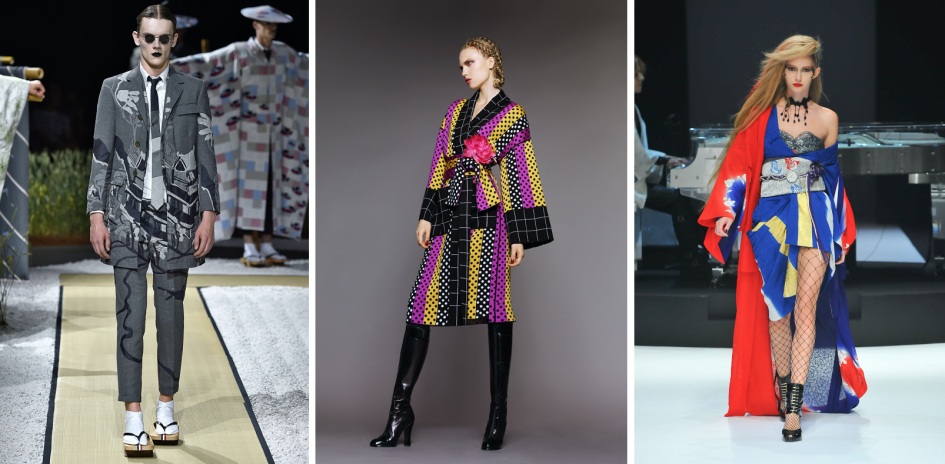
In pictures above:
⁃ Thom Browne, menswear Spring-Summer 2016, Image Courtesy of Getty Images
⁃ Belted wrap coat, designed by Duro Olowu, Autumn/Winter 2015, England. © Duro Olowu
⁃ YOSHIKIMONO©JFWO
Japan itself is currently witnessing resurgence in the interest kimonos. Jōtarō Saitō designs kimono couture for the catwalk, Hiroko Takahashi seeks to bridge the divide between art and fashion, and small, independent studios such as Rumi Rock and Modern Antenna create more casual styles.
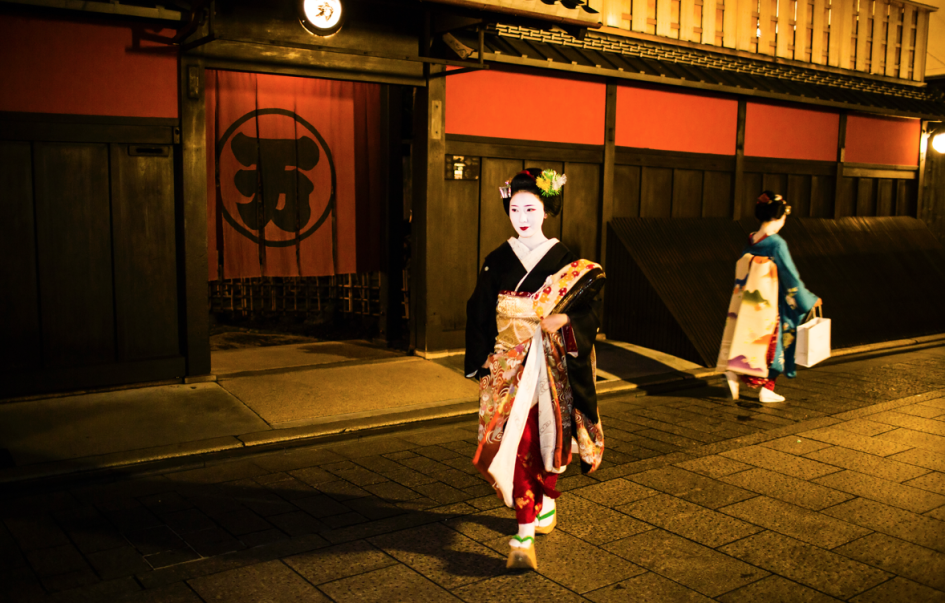
In picture above:
Maikos in Gion Kyoto Japan © Getty Images
Copyright 2024. All right reserved - Terms
